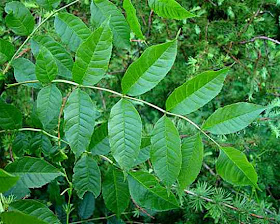|
|
 |
| Ilex aquifolium - Holly |
The greenish-grey twigs are in pairs and are knobbly because
of the swollen leaf-scars. The prominent large black winter buds are oppositely
set. So, too, are its compound-pinnate leaves, 6-9 inches long, comprising 7-15
leaflets with serrated margins and channeled leaf-stalk.
The flowers, which appear well before the leaves, are
purple, short-stalked and in dense, almost knobbly clusters, the precocious
flowering giving a purplish tinge to the whole crown. Some trees are male and
some female, some trees carry both sexes. The winged fruiting strap-shaped
‘keys’, likewise in clusters, each contain a seed at the base. When planted
green they will germinate, but if allowed to become ripe and brown on the tree
(usually by August they remain in clusters throughout the winter, appearing in
silhouette as hanging bats or swarms of birds a waiting migration, until
scattered by the March winds.
 |
| Ilex aquifolium - Holly |
Ash likes alkaline soils, where it regenerates freely form fallen seed.
Silviculturists prefer to plant it on deep rich soils, away from frost pockets.
Its wood, yellowish or greyish-white with sometimes a pale brow heartwood, is
tough, elastic and cleaves easily. Among its important uses are sports goods
(tennis-rackt frames, billiard cues and hockey sticks), oars, bar-hurdles, tent
pegs, tool handles and furniture. It burns well – ‘ash wet or ash dry is fit
for a Queen to warm her slippers by’. It is not a good hedgerow tree, being a
‘robber’ of adjacent soils on farmland.
 |
| Ilex aquifolium - Holly |
 |
| Ilex aquifolium - Holly : Leaves |
 |
| Ilex aquifolium - Holly : Flowers |
 |
| Ilex aquifolium - Holly |
 |
| Ilex aquifolium - Holly : Flowers |
 |
| Ilex aquifolium - Holly : Flowers |
 |
| Ilex aquifolium - Holly |
 |
| Ilex aquifolium - Holly |
 |
| Ilex aquifolium - Holly |
 |
| Ilex aquifolium - Holly |
 |
| Ilex aquifolium - Holly |
 |
| Ilex aquifolium - Holly |
 |
| Ilex aquifolium - Holly |
 |
| Ilex aquifolium - Holly |
No comments:
Post a Comment